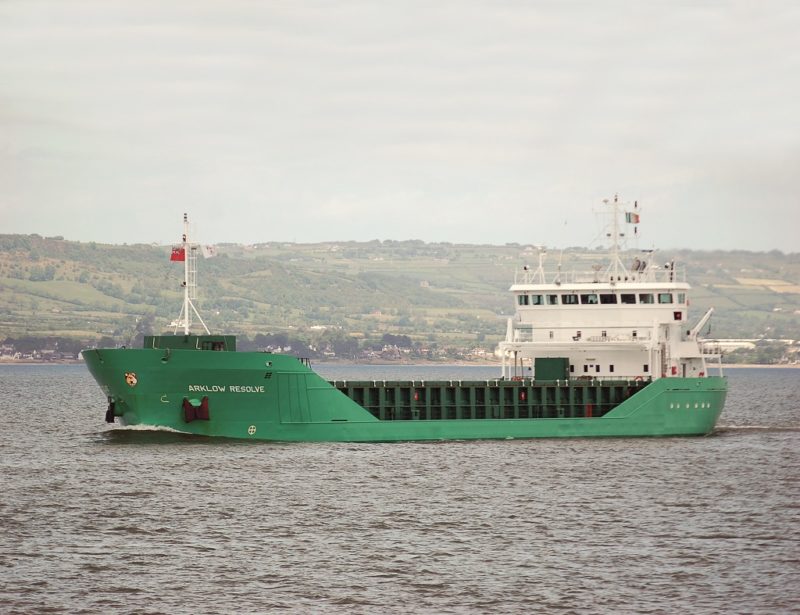
This big fleet currently has 56 owned and managed ships, and is the largest shipping company in Ireland carrying seven million tonnes of cargo per year, much bigger than the former national fleet of Irish Shipping Ltd. (ISL) and also the Shamrock Shipping Company. Arklow is the second biggest and the busiest town in County Wicklow, with a thriving commercial centre, port and maritime museum. It lies at the mouth of the Avoca river, halfway between Dublin and Carnsore Point, the south east corner of Ireland. The discovery of copper at Avoca, six miles upriver, in the 18th century, led to the export of copper in sufficient quantity to establish the port in the 1830s. Small sailing ships and fishing boats were the main users of the port until a former German coaster arrived at the small quay in Arklow as a war prize in 1947, and was renamed Tyrronall by Capt. James Tyrrell. The name of Tyrronall was derived from three letter groups chosen from the family names of Tyrrell, Kearon and Hall, all with family origins in trading auxiliary schooners from the banks of the Avoca river. However, Arklow boatbuilders and coaster owners had declined significantly in numbers by 1966, leading to the setting up of an ‘umbrella’ company, Arklow Shipping Ltd., by Capt. James Tyrrell, Capt. Michael Tyrrell and Capt. Victor Hall. The age of individual Masters running very small coasters was coming to an end, and only by working together to reduce costs, could profits be made.
TYRRELL FAMILY OF ARKLOW
Tyrrell is a well known family name in Arklow, with Capt. James Tyrrell born on 24th April 1907 two years after John Tyrrell, known as ‘Jack’, who was born on 16th June 1905 in Arklow as the son of Michael and Mary Tyrrell. John Tyrrell qualified as a naval architect at Arklow Nautical School in the 1930s, and designed yachts, fishing boats, tenders and pilot boats. One of the more famous yachts he designed was Gypsy Moth III of forty feet in length for Sir Francis Chichester in 1959. John Tyrrell became the first Chairman of Arklow Shipping Ltd. in 1966, and remained active for the remainder of his life as a member of Arklow Harbour Board, and of the RNLI station at South Quay, Arklow. This RNLI station opened in 1826 as the first lifeboat station in Ireland. John Tyrrell & Sons Ltd., yacht and boat builders, were in business until the last boat was completed in 1984.
John died on 29th July 1988 and was survived by three sons, Michael and James, who worked in the family shipping business, and John as Arklow Harbour Master, and also by a daughter.
James Tyrrell Ltd. began trading on 15th October 1959, and James Tyrrell was the main shareholder of the new company in 1966, and brought with him four of the seven coasters that formed the original Arklow Shipping Ltd. fleet in 1966. This quartet were owned by James Tyrrell Ltd., and included Tyrronall of 248 grt, built in Germany in 1935 and purchased after being badly damaged in a grounding in St. Austell Bay in 1947. The others were Murrell of 319 grt built in 1940 at Goole and purchased in 1954, Marizell of 428 grt built by Bodewes at Hoogezand in 1948, and Valzell of 576 grt built by the Caledon yard at Dundee as the Scottish owned Arbroath for the Dundee, Perth & London Shipping Co. Ltd. and purchased in November 1962. Capt. Michael Tyrrell contributed the motor coaster Avondale of 303 grt, built in Holland in 1950, and purchased nine years later, and Capt. Hall contributed two coasters, Kilbride of 321 grt, built at Lowestoft in 1942, and River Avoca of 384 grt, built at Goole in 1948.
The first coaster to be actually registered under Arklow Shipping Ltd. was in February 1970, when a Dutch built coaster of 299 grt was purchased and appropriately named as Arklow. More coasters owned by James Tyrrell Ltd., but managed by Arklow Shipping Ltd. followed, including:-
– The new Darrell of 387 grt in 1970
– Shevrell of 561 grt built in 1954 and purchased in 1971
– Murrell (2) of 1,100 grt built in 1957 and purchased in 1972
– Shevrell (2) of 881 grt built in 1962 as Wirral Coast for Coast Lines and purchased in 1972
– The new Murrell (3) of 951 grt in 1973 and her sister Arklow Dawn
– Valzell (2) of 1,222 grt built in 1966 and purchased in 1973
– The new Cork built coasters Valzell (3) and Serenell of 1,038 grt completed in 1976/77
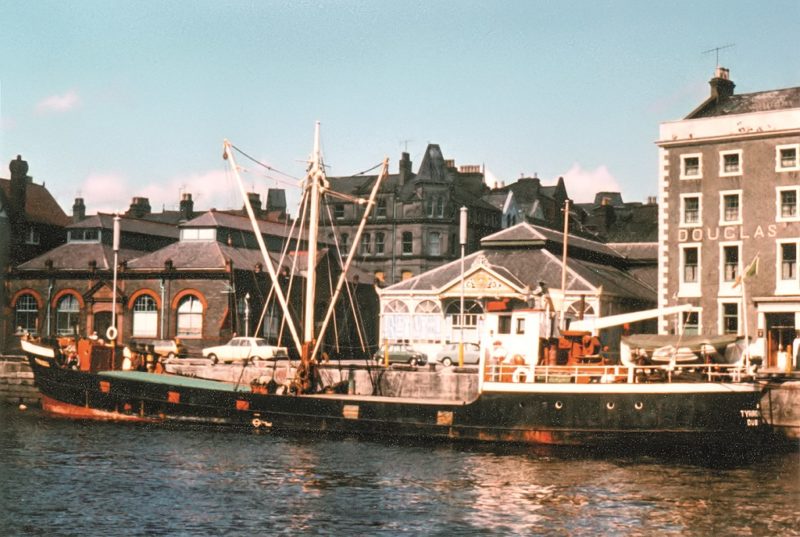
New companies had been set up as the Bay Shipping Ltd. in 1971 and Vale Shipping Ltd. in 1972, but were operated under Arklow Shipping management. Arklow Bay of 533 grt became the first marine casualty on 22nd September 1971 when she foundered during a storm while on a voyage from Antwerp to Arklow with potash and chemicals, fortunately her eight man crew was rescued.
A fleet of eight coasters was being traded in 1978, including Arklow Bridge, Arklow Dawn, Arklow Vale, Murrell, Serenell, Valzell, Carrigrennan and Joan-T. Rapid expansion took place in 1984 when nine coasters were purchased to give a medium sized fleet of 15 coasters. The fleet had two nomenclatures at this time, with eight ships having ‘Arklow’ prefixes to their names in Arklow Abbey, Arklow Bridge, Arklow Castle, Arklow Dawn, Arklow Glen, Arklow River (ex Bay Fisher), Arklow Vale and Arklow View. Five were owned by James Tyrrell Ltd. as Darrell, Murrell, Serenell, Shevrell and Valzell.
Further coasters were purchased between 1985 and 1990, including Arklow Brook of 3,150 dwt, a sister of Arklow Bridge, Arklow Vale (2) of 2,700 dwt, a sister of Arklow Valley, and two coasters registered under the Coastal Shipping PLC, a new company set up under the Shipping Investments Scheme of the Irish Government. This pair were Inisheer and Inishowen and were soon joined by Inishark ex Darrell built in 1982. Also, six low air draft coasters from German yards of 1,750 dwt were completed as Arklow Bay, Arklow Manor, Arklow Marsh, Arklow Mill, Arklow Moor and Arklow Meadow with hydraulic navigating bridges that could be lowered and folding masts.
Unfortunately, Arklow Victor capsized and sank only seven months after her delivery on 17th December 1989 off Concarneau while on a voyage from Bayonne to Manchester, and this loss was followed by another three years later. Arklow Castle was wrecked 60 miles south of St. Nazaire on 30th November 1992 near Les Sables d’Olonne while on a voyage from France to London. The fleet began to be registered at the small port of Arklow at the beginning of 1988, a move that the company had promoted and supported for a long time, with sixteen people employed in the office and well over 200 seafarers after the entry into service of eight new low air draft ‘V’ class of 4,299 dwt from the Hugo Peters yard at Wewelsfleth near Hamburg. These were Arklow Vale, Arklow Valley, Arklow Valour, Arklow Venture, Arklow View, Arklow Villa, Arklow Victor and Arklow Viking. They had an overall length of 88.2 metres, moulded beam of 13.7 metres, and a loaded draft of 5.8 metres and could carry 173 TEU of containers either on deck or in the hold, and had service speeds of 11.0 knots.
Arklow Venture lost part of her deck cargo of containers in rough seas off Land’s End on 3rd March 1992 while on a voyage from Greenore to Rotterdam. There were two further coastal container ships in the fleet:-
– Arklow Rose of 326 TEU capacity and equipped with two container cranes was purchased at auction at Rotterdam in June 1987 and used for three years on the Bilbao to Northern Europe service, and as a feeder container ship in the Caribbean between Fort de France (Martinique) and Pointe de Pitre (Guadeloupe) and between the Brazilian ports of Rio de Janeiro and Santos. She was also chartered from Eastern Seaboard U.S.A. ports to Mediterranean ports such as Palma de Mallorca, Malta and Alexandria until sold in 1990 to French owners and renamed Cygne and was broken up in 2014 after a career of thirty years.

– Arklow Castle (2) of 532 TEU capacity, which was purchased in 1996 and long term chartered to Seawheel for a service from Greenock, Dublin, Waterford and Avonmouth to Bilbao. She was also slot chartered by MacAndrews & Co. Ltd. for the same service until sold on to German owners in 2005 and renamed Meriwa.
Arklow Beach of 5,482 dwt was built in 1976 as Sandgate for Turnbull, Scott & Co. Ltd. until sold to James Fisher of Barrow in 1982 and renamed Atlantic Fisher. She traded for Arklow Shipping Ltd. from 1988 to 1995 in the coastal Biscay, North Sea and Baltic trades until sold to A/S Hansen-Tangens of Norway for deep sea trading e.g. the export of bulk cement from the port of Arguineguin on the southern tip of the island of Gran Canaria. She had also lifted many cargoes of summer grain from the Tyne and from Southampton during her career in the green colours of Ireland.
Two larger vessels were completed during 1995/96 by the Appledore Shipbuilders Ltd. yard in Devon as Arklow Bridge and Arklow Brook. They were of 7,184 grt with two holds and two hatches, which were strengthened for the discharge of cargo by grabs of up to ten tonnes in weight. They had service speeds of 13 knots from six cylinder MaK diesel engines. They frequently carried steel cargoes, and were sold in 2005 to Maltese companies, with Arklow Bridge renamed as Clydenes and used since then in the coastal Scottish trades to distribute coal from the Hunterston deep water berth near Largs, and with Arklow Brook renamed as Rose Brook.
The four members of the ‘F’ class of 4,250 dwt were purchased in 1997 from the Douglas (IOM) subsidiary of the German firm of C. F. Ahrenkiel and had been built by the Ferus Smit yards in Holland at Foxhol and Hoogezand five years earlier. They were renamed Arklow Fame, Faith, Fortune and Freedom. The last coasters to have traditional Tyrrell names in the fleet were sold during 1996/98 in Valzell of 1,600 dwt and completed at Cork in 1976, and Shevrell (3) of 2,690 dwt and completed at Delfzijl in 1981. The latter was renamed Garibaldi with management retained by Arklow Shipping Ltd., and Valzell became the ubiquitous Skylark in 1996. Two further vessels were purchased for Coastal Shipping PLC as Inishowen (2) of 3,250 dwt, an ungeared product of the J. J. Sietas yard at Hamburg in 1988, whereas Inishfree (2) of 5,412 dwt was a geared ship equipped with two cranes of 16 tonnes capacity and could carry 146 TEU of containers when owned between 1997 and 2000. Inishfree was purchased in early 1997 as Lenneborg by Coastal Shipping PLC, but suffered a bad galley fire on 21st February 1997, unfortunately with the loss of one crew.
An analysis of the 27 owned and managed vessels traded by the company during 1998 and 1999 showed that the vast majority of voyages were made to the Shannon river in West Ireland, in the Irish Sea, North Sea, Bay of Biscay and the Baltic, with only occasional voyages further afield to Russian Baltic ports and the sunny Mediterranean coast of Morocco. Nine of the fleet were trading to Northern Spain with scrap from Liverpool or Manchester and returned with grain from Bayonne near Biarritz and Bordeaux to the Cerestar at the Manchester end of the Manchester Ship Canal.
This pattern of trading included the seven members of the new ‘S’ class of 3,200 dwt that entered the fleet after completion during 1995/99 by the Barkmeijer yard at Stroobos in Holland as Arklow Sand, Sea, Sky, Spirit, Spray, Star and Surf. They had service speeds of 11 knots from eight cylinder MaK diesel engines of 2,066 bhp. Nearly all of this class had goalpost masts topped with radar scanners, and had a single hold and hatch and were strengthened for heavy cargoes and the carriage of containers. They had dimensions of overall length of 90.0 metres and a moulded beam of 12.5 metres with a loaded draft of 4.65 metres. They could thus unload at berths with only five metres of alongside water e.g. the Baltic Wharf on the south side of the Crouch river in Essex, six miles from the sea, with timber from the Baltic or chipboard from La Coruna, and also ports in Portugal entered over shallow sandbars.
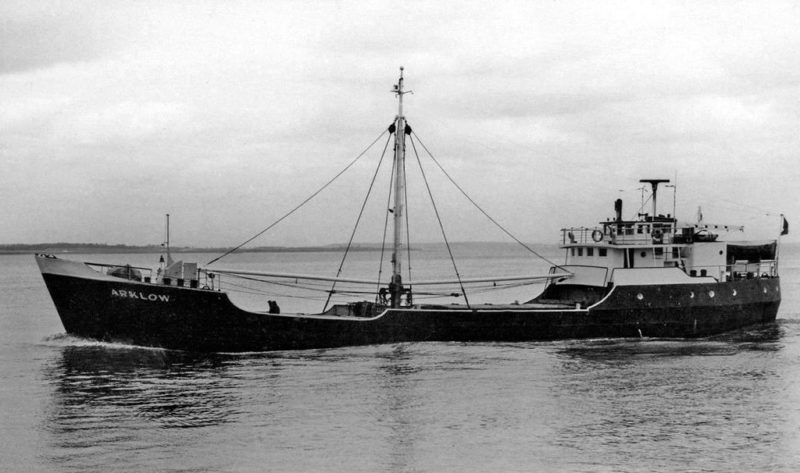
Arklow Sky with a crew of seven arrived at Bilbao on 21st September 2010 and began unloading her cargo. However, at 1905 hours later that day an accident happened when a hatch attached to a hatch crane by its hooks fell into the hold, taking with it the First Mate, who was operating the hatch crane. He fell eight metres into the hold and sustained serious back injuries and was admitted to hospital in a critical state in a coma. He eventually awoke from this coma one month later and was repatriated to his homeland and admitted to a rehabilitation clinic. The operation of lifting the separate hatches by the use of a hatch crane was the subject of the subsequent enquiry, and the use of safety harnesses was recommended at all times.
Twenty three of the company fleet during the period from 1998 to 2000 had ‘Arklow’ prefixes to their names, with the managed vessels being Inisheer, Inishfree, and Inishowen as well as the managed former Shevrell (3) as Garibaldi. Inisheer experienced engine trouble on her voyage from Hamburg to Newport in November 2000 and put into Portland for four days of engine repairs before continuing her voyage to Newport.

A NEW MILLENNIUM
The Head Office of the company was at the North Quay in Arklow at the end of the century, with three members of the Tyrrell family on the Board of directors in Sheila Tyrrell, born in October 1948, as Chairman, and James Stewart Tyrrell, born in November 1942, as Managing Director, and ably supported by Barry Tyrrell. Sheila Tyrrell had become the first woman in 1980 to be Chairman of the Irish branch of the Institute of Chartered Shipbrokers. The subsidiary companies were James Tyrrell Ltd., Arklow Shipping (Overseas) Ltd. formed on 19th October 1987, Coastal Shipping PLC, Devon Line Ltd., Invermore Shipping Ltd. and Sailaway Sailor PLC. An 18% stake in the main company was taken in 1999 by Dutch venture capital group NPM Capital.
Three larger ‘D’ class had joined the fleet from the end of 1999 to the first few months of 2000. Two former Jebsen mini bulkers of 12,300 dwt were purchased at auctions in Rotterdam and Trinidad, their Hong Kong owners having been declared bankrupt. This pair had been built in 1982/83 by the Miho Zosensho yard at Shimizu in Japan, and were twin funnelled with two deck cranes of 15 tonnes capacity serving four holds and four hatches, and service speeds of 13.5 knots from nine cylinder Pielstick diesel engines, They were renamed Arklow Day and Arklow Dawn, and were joined by a third mini bulker of the ‘D’ class as Arklow Dusk. This was the Polish mini bulker Kopalnia Ziemowit of 11,722 dwt completed at Szczecin in 1991 and purchased by Coastal Shipping PLC and managed by Arklow Shipping Ltd. She had five deck cranes of 16 tonnes capacity serving five holds and five hatches, and a service speed of 13.5 knots from a six cylinder B & W oil engine.
The three larger ‘D’ class mini bulkers were transferred to the alumina trade in 2002 from Aughinish on the Shannon river to Blyth for Alcan Ltd. and to Husnes in Norway for Norsk Hydro, these contracts had previously been won by Stephenson Clarke Ltd. with four similar mini bulkers of 12,000 dwt. Raw bauxite arriving in deep sea bulkers in the Shannon river is then chemically treated to produce alumina, which is then smelted to produce aluminium. The twin deck cranes of Arklow Day and Arklow Dawn were removed to make the regular discharge of bulk alumina easier and faster by the big ‘sucker’ cranes. This ‘D’ class were sold on in 2003 and 2004 to new owners, with Arklow Dusk becoming the Italian registered Rubicone, and the others were sold to Greek owners and renamed Polydefkis and Castor.
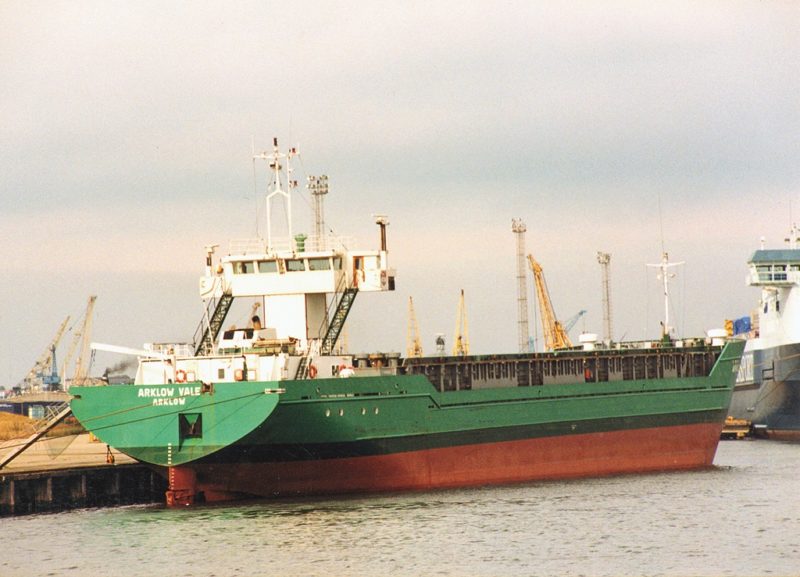
LARGE ‘R’ CLASS of 16 SHIPS
On 1st January 2002, the Dutch coaster firm of Hanno Shipping B. V. was renamed as Arklow Shipping Nederland B.V., having been purchased three years earlier with management retained in Holland. This Dutch fleet of six vessels each of 4,200 dwt had typically Dutch names of Bengalen, Ikiena, Marja, Katja etc with either red or blue hulls. Three members of the new ‘R’ class of 4,400 dwt of Arklow Rally, Arklow Rambler and Arklow Ranger were also registered under this Dutch company, which also managed the earlier ‘S’ class. The ‘R’ class were completed by Dutch yards at Lemmer and Stroobos during a five year period from 2002 to 2007 as Arklow Rose, River, Rock, Rover, Racer, Rebel, Rally, Rambler, Ranger, Resolve, Rainbow, Ruler, Rival, Rogue, Raven and Raider.
The ‘R’ class are ungeared twin hull vessels with a single hatch and service speeds of 11.5 knots from either MaK or Wartsila diesel engines. They are multi purpose vessels able to operate in the feeder container trades with containers stored both on deck and in the holds. Arklow River arrived at the Solway port of Silloth in April 2008 with 4,150 tonnes of agribulks from Holland, the largest ever cargo handled in the confined Cumbrian port for Carrs Fertilisers Ltd. Arklow Ruler and Arklow Forest sailed in company on 6th September 2018 from Ipswich, both loaded for Drogheda. Arklow Resolve transported parts of decommissioned turbines from Gdynia to Brest in July 2015. The turbine was cut into three cylindrical sections and securely lashed for transport on her hatches on a voyage that took the short cut through the Kiel Canal to the North Sea. Arklow Racer ran aground on 13th July 2005 at the entrance to Fowey in restricted visibility just before she embarked the pilot to south east of Punch Rocks, and was later refloated.
Arklow Resolve suffered engine trouble twice in September 2018 while on a voyage from Gothenburg to Seville with fertiliser. The first time was on 12th September shortly after leaving Gothenburg and she drifted off the Swedish coast at Marstrand until the Swedish Coastguard attended the casualty and towed her back to Hono water in Gothenburg harbour. She had onboard at the time 86 tonnes of heavy fuel oil and 27 tonnes of diesel oil, and continued her voyage until a second breakdown occurred on 24th September off the Devon coast at Plymouth in the English Channel. She was again towed into port at Fowey and repaired and she eventually reached Seville with the cargo many days late from her original expected arrival of 27th September. Arklow Resolve and Arklow Rover were acquired by Wilson Line of Norway in December 2019.
Arklow Resolve and Arklow Brook were used on 28th December 2018 to tranship grain from Argentina at Moville Bay at the entrance to Lough Foyle from the five hold bulker Yara Sparrow of 55,340 dwt, built in 2013 by the Hyundai Vinashin yard in Vietnam. The cranes of the bulker were used to discharge overboard to each of the Arklow vessels on her port and starboard sides, with part of the cargo having already been discharged at the Ringaskiddy Terminal at Cork.
Arklow Rival was disabled with mechanical damage in the English Channel 70 miles NW of Guernsey on 18th February 2018 while on a voyage from Lisbon to Sunderland with cement. Arklow Rainbow, her sister, came to her aid while on her voyage to Warrenpoint and towed her north from the heavy traffic of the separation lanes to hand over to a British tug, which towed her to Fowey two days later.
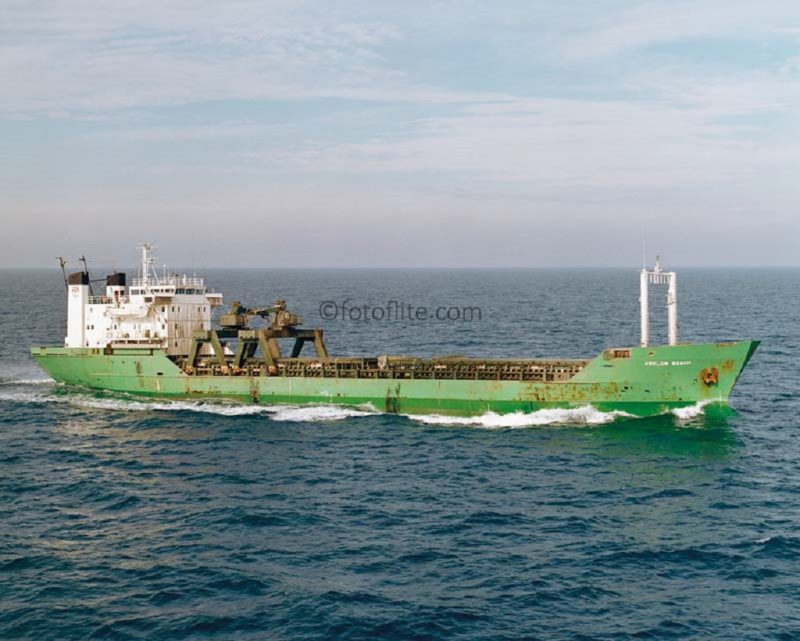
The ‘R’ class have been used on all of the regular Arklow Shipping Ltd. trades in European waters, with only half of the class still in service with the company in June 2020, and Arklow Rose having been sold to Charles M. Willie & Co. Ltd. of Cardiff in 2016 and renamed Celtic Venture.
Arklow Raven is one of the ‘R’ class still trading for the company, and arrived at Glasgow in ballast on 30th October 2019 from Belfast.
NEW ‘B’, ‘C’, ‘D’, ‘F’, ‘M’, ‘V’ AND ‘W’ CLASSES
A step up in size to 14,000 dwt mini bulkers was made during 2003 and 2004 to operate on long term charters in the alumina and other trades. Three ‘W’ class vessels from the Kyokuyo yard at Chofu in Japan in Arklow Wind, Arklow Wave and Arklow Willow were ungeared vessels with four holds and four hatches, and service speeds of 13.5 knots from six cylinder Wartsila four stroke diesels of 5,914 bhp.
Arklow Wave was launched on 20th October 2003 by Sheila Tyrrell, Chairman of the company, and Arklow Wind became the one thousandth ship to unload at the Alcan berth at Blyth on 16th April 2004 after a long 33 year relationship between Alcan and the Port of Blyth. This ‘W’ class vessel was dressed overall with flags for the occasion, and a plaque was presented to her Master by the Port of Blyth. At 0330 hours on 2nd December 2007, a trainee cadet named Brian Daly, went missing while on duty on Arklow Willow at King’s Dock in Swansea, with his body recovered from the dock three days later and foul play not suspected. The ‘W’ class were trading in April 2008 mainly in European waters, and were frequently seen at Birkenhead discharging maize from Bayonne or alumina from Aughinish at Blyth.
Arklow View was the last of the remaining original ‘V’ class to be sold off in 2006, and she was sold to owners in Nassau and renamed Jomi, with management retained by Arklow Shipping Ltd. She was one of thirty vessels in the Irish fleet managed in Arklow in April 2008, with another ten vessels managed in Holland. Three further vessels of 4,900 dwt and built in 1999 were purchased in 2004 and 2005 and given the ‘V’ class names of Arklow Venture, Venus and Viking. Viking completed her third special survey with flying colours during June 2014.
Ten new ‘F’ class of 4,480 dwt were completed between 2006 and 2011 by the Astilleros de Murueta yard S. A. at Gernika-Lumo, the town in the Basque region of Northern Spain that was mindlessly and savagely destroyed by an aerial bombardment by the Condor Legion of the Luftwaffe on 26th April 1937 with large loss of life during the Spanish Civil War. Arklow Faith, Fame, Flair, Fortune, Freedom, Future, Forest, Field, Falcon, and Fern have a cargo carrying capacity of 6,056 dwt with a service speed of 10 knots from a six cylinder MaK oil engine of 2,689 bhp. Arklow Fortune made the first welcome visit to her home port of Arklow on 4th May 2017, the first time that a company ship berthed at the North Quay for ten years.
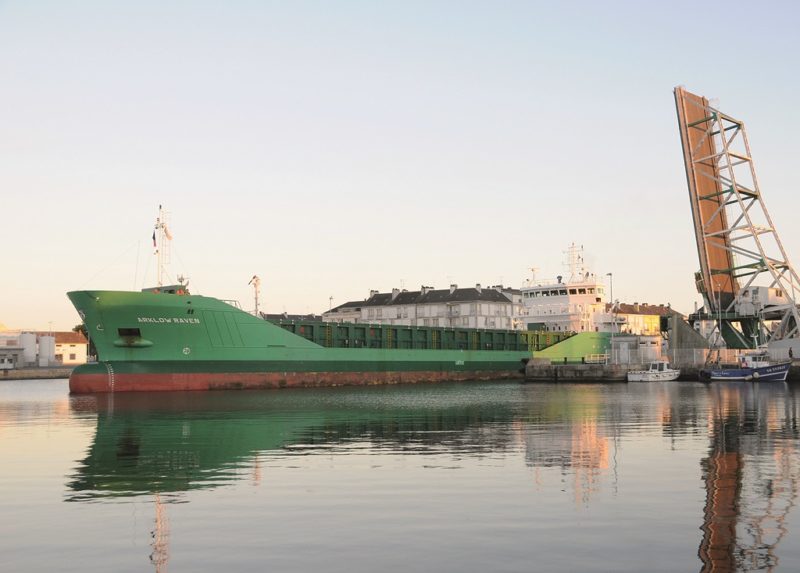
Arklow Fortune ended up with her stern aground on the breakwater when entering Les Sables d’Olonne port near the Ile de Re on the Biscay coast of France. She was refloated on 19th December 2019 with the aid of two tugs and towed into port, having sustained damage.

The smaller Arklow Shipping Ltd. vessels regularly unload grain and then reload grain products at the Cerestar Wharf at the Manchester end of the Manchester Ship Canal, or scrap at the Irwell Park Wharf on the canal for Northern Spain, and then make a short ballast voyage to Bayonne to load grain.
The other members of this busy fleet are operating in the petroleum coke and coal, grain, limestone, salt, potash and alumina trades, as well as in the project cargo trades of outsize cargo, offshore structures, oil pipes, steel coils and rails and container trades. Fleet chartering is split between the Arklow Head Office and the Branch office in Rotterdam of Arklow Shipping Nederland B. V. and formerly Hanno Shipping B. V., with cargoes sourced from a variety of ports e.g. small limestone quarries in North Wales to giant ports such as Rotterdam.
The three ‘W’ class of Arklow Wave, Wind and Willow were sold on for further trading during 2016 and 2017, and replaced by a new quartet of ‘W’ class in Arklow Wave, Willow, Wind and Wood after being launched sideways at the Leer yard of Ferus Smit Shipbuilders during 2018 and 2019. The sideways launches are spectacular and have been used in a well performed fashion at Leer for many years, with the massive wave of displaced water swamping the other side of the canal.
They are of 16,643 dwt with a twin hold cubic capacity of 19,316 metric cubic metres, a maximum load on tank tops of 20 tonnes per square metre, are Ice Class 1A, and have a service speed of 13.5 knots. The German banks IPEX and DEKA provided $60.8 million of funding for the quartet, which are deployed in the Irish trades, North Sea and Baltic Sea.
Arklow Willow traded in the St. Lawrence river in Canada for six months during 2018, loading aluminium ore at Baie Comeau on the north bank for Hamilton (Ontario), and also visited Trois Rivieres on the north bank, Sorel and Contrecoeur on the south bank, as well as Sandusky and Toledo in Ohio. Arklow Wave sailed from Delfzijl for sea trials from the Ferus Smit yard on 16th October 2018, and has since transported alumina from Aughinish to Odda in Hordaland County on the Hardangerfjord in Norway. She has since visited the ports of Ipswich, Antwerp, La Pallice, Amsterdam, Huelva, Ceuta, Cork and Marseille. Arklow Wind was launched on 1st March 2019 and completed one month later, and Arklow Wood was launched in January 2020 and completed one month later, and was moored at Eemshaven on 6th June 2020.
A big fleet of 34 vessels managed at Arklow, and a further ten vessels managed at Rotterdam in 2009, had six larger four hold ‘M’ class vessels of 14,990 dwt and 18,109 cubic metres capacity on order from shipbuilders Daesun Shipbuilding & Engineering Co. Ltd. and the Mokpo Shipbuilding Industry Co. Ltd. for delivery up to 2013. They have dimensions of overall length of 136.47 metres, moulded beam of 21.0 metres, moulded depth of 11.4 metres with a loaded draft of 8.48 metres, and a service speed of 14.5 knots from a MaK diesel engine of 7,342 bhp or 5,400 kilowatts power.
Arklow Muse, Moor, Meadow, Mill, Marsh and Manor are used in all of the traditional Arklow Shipping Ltd. trades. Arklow Manor arrived at Blyth on 17th April 2010 with alumina from Aughinish and made regular voyages to Aughinish for the next eight years.
She had sailed from Ceuta on 6th July 2018 for Marseille and arrived at Leith on 4th August 2018 on her return before sailing again for Aughinish. She arrived at Bilbao on 24th August 2018 and sailed for Dublin, Belfast, Ghent and Wandelaar in Belgium to navigate the river to Bruges. Arklow Manor is a regular trader to Warrenpoint, and transitted the Kiel Canal on 8th February 2020 to load a cargo in the Baltic, and arrived in the port of Bilbao in June 2020 to load yet another cargo.

Arklow Meadow arrived at Blyth on 31st December 2010 with alumina from Aughinish, but ran into trouble when she arrived with grain at Warrenpoint on 5th December 2012, which led to an evacuation of the port and the surrounding area, with twenty crew and dockers taken to the Daisy Hill Hospital in Newry and the Craigavon Area Hospital. The packets of aluminium phosphide pesticide that she carries to keep down the number of rodents on the ship had become wet and gave off toxic fumes and gas.
She unloaded a cargo at Tekirdag in Turkey on 25th June 2018 and then sailed for Sagunto, Huelva, Setubal and arrived at Kokkola in Finland on 20th August 2018. She moved across the Gulf of Finland to Tallinn and Paldiki in Estonia a week later and then sailed up the Gulf of Finland to St. Petersburg, arriving on 30th August 2018.
Arklow Muse sailed from Kalundborg on 7th July 2018 for Belfast, and then loaded biomass wood pellets at Riga in Latvia for the Tyne, where she arrived on 5th August 2018.
She returned to the Baltic and Gdynia on 26th August 2018 and sailed two days later to move to an anchorage off Gdynia to await orders for Leningrad, where she arrived on 31st August 2018.
She loaded alumina at Aughinish on 10th September 2018, and has continued trading in Europe e.g. arriving at Terneuzen on 9th August 2019.
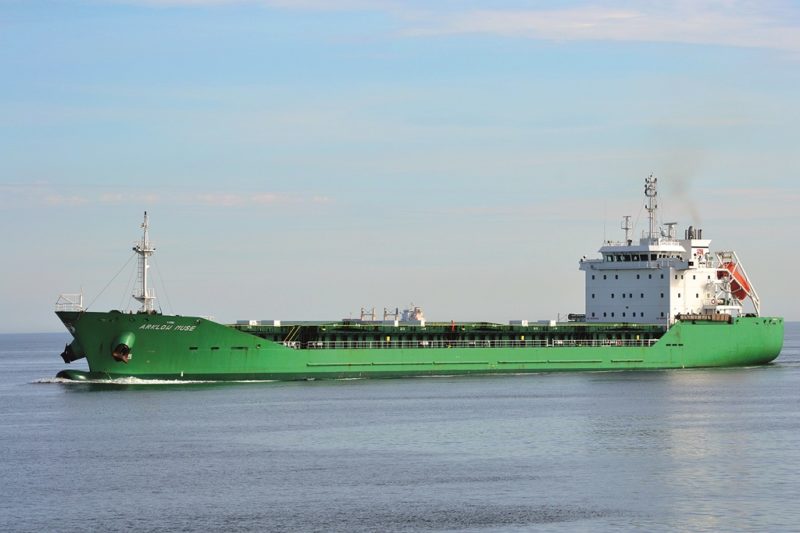
Arklow Mill loaded fertiliser at the Heroya plant in Norway on 17th November 2017 for Antwerp, and has also continued trading in Europe to ports such as Aughinish, Lisbon, Kalundborg, Leith, Rosyth, Skagen, Gothenburg, Gdansk, Ravenna, Dublin, the Kiel Canal, Rouen, Belfast, Dunkirk and the big port of Rotterdam.
A quartet of grey hulled bulkers of 11,023 dwt and a cubic hold capacity of 13,008 m3 joined the fleet during 2017 and 2018 from the bankrupt Flinter Group, which collapsed owning a fleet of 28 ships in 2016.
They were repainted with green hulls and new white funnel colours with the Arklow badge as the ‘D’ class of Arklow Dale (ex Flinter Arctic), Dawn (ex Flinter Atlantic), Day (ex Flinter Aland) and Dusk (ex Flinter America) with service speeds of 14.0 knots.
Arklow Day sailed from Gdynia on 26th July 2018 for Holtenau and passed through the Kiel Canal en-route to the Amalfi coast in Italy and the port of Torre Annuziata, where she arrived on 20th August 2018. She returned to Dordrecht in Holland and then loaded a cargo of alumina at Aughinish on 7th September 2018.
On 10th December 2019, five of her ten men crew were seriously injured in the Bay of Biscay after sailing from Aviles and shortly afterwards encountered rough seas with waves nine metres high, and the men were airlifted off to a Spanish hospital. The ship was then diverted to the port of El Musel on the Cantabrian coast to await crew replacements.
The quartet were built by the Ferus Smit yard at Westerbroek, and are equipped with a small deck mounted gantry crane, and have a service speed of 14 knots from a MaK diesel engine of 4,000 kilowatts power.
The handy size fleet of 6,100 dwt to 6,250 dwt was renewed during 2015 to 2018 by five ‘C’ class and ten new ‘V’ class named as Arklow Cliff, Clan, Castle, Cape, Cadet, Villa, Viking, Venus, Venture, Vanguard, Valour, Valley, Valiant, View and Vale.
The new ‘V’ class is an ‘Eco Trader’ design of Dutch shipbuilders Royal Bodewes, with some of the class launched spectacularly in sideways launches, and towed by two tugs, one at the bow and one at the stern, through the maze of Dutch river and canal systems to the sea for their maiden voyages.
Arklow Castle arrived off the Dutch coast on 27th November 2017 straight from the shipyard, and has since loaded and discharged many cargoes of grain, including one loaded at a Lowestoft mill on 12th August 2019.
Many of the new ‘V’ class with a hold cubic capacity of 221,000 cubic feet had their straight energy saving bow sections completed separately to await the construction of the remainder of the hull, and were then joined together.
A ‘B’ class of six new vessels of 8,660 dwt with a twin hold grain cubic capacity of 9,902 m3 (350,000 cubic feet), and with a slender, straight stem and bulb-less bow, was completed as Arklow Brave, Breeze, Bank, Bay, Beach and Beacon by the Westerbroek yard of Ferus Smit B. V. between 2014 and 2015. They have an overall length of 119.5 metres, moulded beam of 14.99 metres, a moulded depth of 9.70 metres, and a loaded draft of 7.186 metres and a service speed of 13.0 knots when fully laden from a MaK main engine.
The new bow was designed to take into account the various loading drafts in the grain trades and the wave conditions encountered in service to give less resistance to the waves and a better performance than a bow fitted with a bulb.

A new ‘A’ class is under construction in Holland and the three members so far delivered are very similar ships to the ‘B’ class with the same metric hold capacity and the same number of decks in their superstructures. Arklow Abbey, Arklow Accord and Arklow Ace are currently in service, with Arklow Ace having successfully tested the launch of her freefall lifeboat before delivery on 9th June 2020.
Arklow Bay was launched on 7th March 2014, and after completion, she has since loaded cargoes in Norway on 16th January 2015 and on a regular run between Tilbury Dock and Rotterdam to give a next day arrival at the big Dutch port. She discharged shipment of stone at the Port of Ipswich on 31st March 2015, the largest ever cargi in the port’s history with 8,229 tonnes of stone loaded at Belfast.
The client was Lafarge Tarmac and the cargo was delivered to their state of the art asphalt plant at Cliff Quay in Ipswich. The port is owned by Associated British Ports (ABP) and the previous highest cargo of stones delivered there was 7,371 tonnes, with 30% of port total tonnage being for the construction industry, including bricks, stone, sand and gravel as well as a large volume of cement.
MOVE INTO DEEP SEA TRAMPING
Two five hold Handysize bulkers of 34,905 dwt with a grain hold capacity of 46,951 metric cubic metres and a bale hold capacity of 45,000 m3 were ordered in 2011 from the Daesun Shipbuilding & Engineering Company in South Korea for delivery during 2013 and 2014.
They have dimensions of overall length 182.0 metres, moulded beam of 30.0 metres, moulded depth of 10.0 metres, and a loaded draft of 6.8 metres, and a service speed of 14.0 knots when fully laden from a M. A. N. diesel engine. Their four Macgregor electric cranes of 30 tonnes lifting capacity are painted red, and a straight stem was fitted with a bulb.
They continued the names in the Arklow Shipping Ltd. fleet of Arklow Spray and Arklow Spirit, both built in 1996 by the Barkmeijer yard at Stroombos and sold in 2012 and renamed BBS Spray and BBS Spirit.
The new Arklow Spray was delivered after her sister in February 2014 and loaded a maiden cargo of steel coil in the Far East for Bilbao and Liverpool. The new automated steel handling facility at the Port of Liverpool received 11,000 tonnes of steel coil when she arrived on 30th March 2014.
Sheila Tyrrell, Chairman, and Adrian Teggin, director of Arklow Shipping Ltd., were invited by the Port of Liverpool to mark the occasion of her first call in the U.K. with a plaque presented to Capt. Marcin Jablonski, which will stay with the vessel for the remainder of her seagoing career. Arklow Spray completed her maiden voyage with discharge of the last of the steel coil in Antwerp. The Port of Liverpool is no stranger to the green hulled ships of Arklow Shipping Ltd., with 169 of their ships entering the Mersey in 2013 alone.
Arklow Spray made a maiden arrival in the Port of New York on 21st November 2017, arriving in the Hudson river to load her cargo.
She was later in Nemrut Bay in Turkish waters and sailed on 30th April 2018 for Fazendinha and Itacoatiara in Brazil, where she arrived on 4th June 2018 and 8th June respectively after bunkering at Gibraltar. She then returned to the Baltic and arrived at Ventspils in Latvia on 9th July 2018 and then sailed to Steenbank for orders that took her to Ghent, where she arrived on 17th July 2018 to load cargo as well as at Amsterdam, for a voyage to Iskenderun in Turkey, where she arrived on 11th August 2018.
She has continued deep sea tramping, and was seen arriving at Delfzijl in Holland in ballast on 6th May 2020, and then arrived at beautiful Port Everglades in Florida ten days later.
She was anchored off the Florida coastline on 11th June 2020 awaiting orders to load yet another bulk cargo for a worldwide voyage to far off ports.
Arklow Spirit was completed a year earlier than her sister in 2013, and arrived at Brake on the river Weser on 19th September 2014. She made a maiden arrival at the Port of Dublin in November 2017 to dock in the Alexandra Basin in the port with animal feed from Porte Vila do Conde near Belem in Brazil. A part of this cargo was unloaded at the Ringaskiddy Terminal to the south of Passage West and Cork, with her green hull making an impressive sight as she moved up the channels into Cork and Dublin.
She then loaded cargo on 2nd June 2018 at New Orleans and in the Mississippi delta and also at Progreso in Mexico and transitted the Panama Canal to Vancouver. She then loaded ore in British Columbia for delivery to the Belledune (NB) lead and zinc smelter of Glencore Trading to the south of the Gaspe peninsular near Bathurst, and which straddles both Gloucester County and Restigouche County.
After sailing from Belledune at the end of September 2018, she has since loaded cargo at Tarragona in Spain in January 2020, and at Constantza in the Black Sea in June 2020.

POSTSCRIPT
The modern fleet of Arklow Shipping Ltd. has a large number of single deck box hold general cargo ships and container fitted ships suitable for a wide range of grain, cereals, project cargo, and all other general and bulk cargoes. The fleet is classed for trading by classification societies such as Bureau Veritas and Germanischer Lloyd, and is entered into the North of England P. & I. Club in Newcastle for insurance of hull, war risks and cargo.
The company also has two Handysize bulkers of 34,905 dwt in worldwide tramping, and the strategy of the company is to regularly renew the fleet with newbuildings. Outline planning permission was given in August 2019 to Arklow Shipping Ltd. to build a new three storey Head Office at North Quay, Arklow with a floor area of 2,519m2, a new main entrance and a new service entrance onto Mill Road.
One of the staple trades of the company is alumina from Aughinish on the Shannon river and the largest alumina refinery in Europe. The plant was constructed between 1978 and 1983 and had an initial capacity of 800,000 tonnes of alumina per year, this has since been raised to 2 million tonnes per year. The plant has its own 160 megawatt power station as the Bayer process of transforming raw bauxite into alumina is very energy intensive. The very long pier leads to an outer jetty of length 285 metres to berth deep sea bulkers bringing in raw bauxite, and an inner berth of length 200 metres for the export of processed alumina. The alongside depths are 12.5 metres and 11.0 metres respectively, with the maximum depth in the channel from sea to berth at 13.0 metres plus tidal water.
Bauxite arrives in bulkers of up to 60,000 dwt from Jamaica, West Africa, Canada and other worldwide mines, and the processed alumina is exported to the U. K., Norway and Canada to be further refined into aluminium. The unloading rate at Aughinish for raw bauxite is 1,000 tonnes per hour, and the loading rate for processed alumina is 600 tonnes per hour. The green hulled Arklow vessels move up the Shannon river past the Moneypoint jetty of length 380 metres for giant bulkers of up to 150,000 dwt to bring in coal for the only coal fired electricity power station in Ireland.
This 915 megawatt capacity power station was opened during 1995 to 1997. They also pass Foynes Dock, a short distance downstream from Aughinish, with three jetties of maximum length 395 metre for dry bulk, breakbulk, liquid and project cargo. Foynes Dock handles ships up to 200 metres in length, but can cope with certain types of ship of up to 229 metres in length. I would like to send very best wishes for the future of their go-ahead shipping company to the Head Office, Marine Superintendents, and the big seafaring staff.
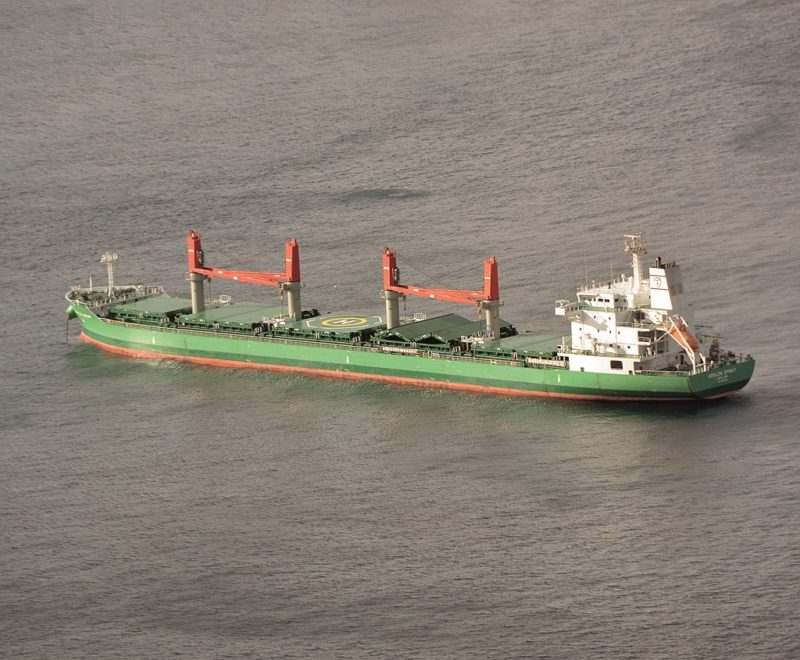

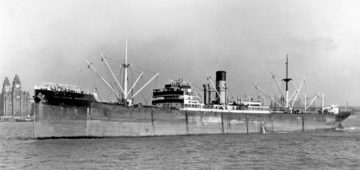


Comments
Sorry, comments are closed for this item